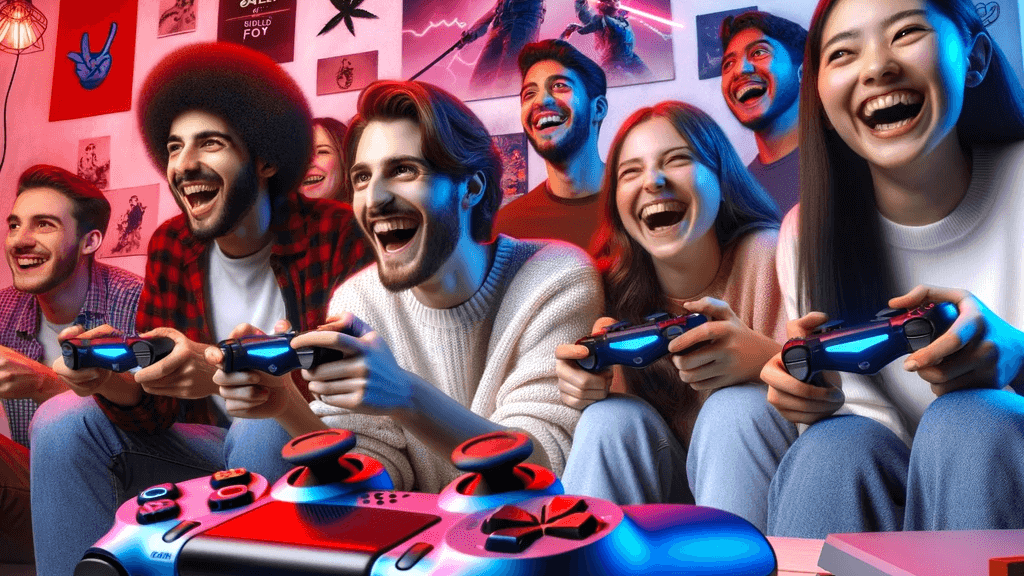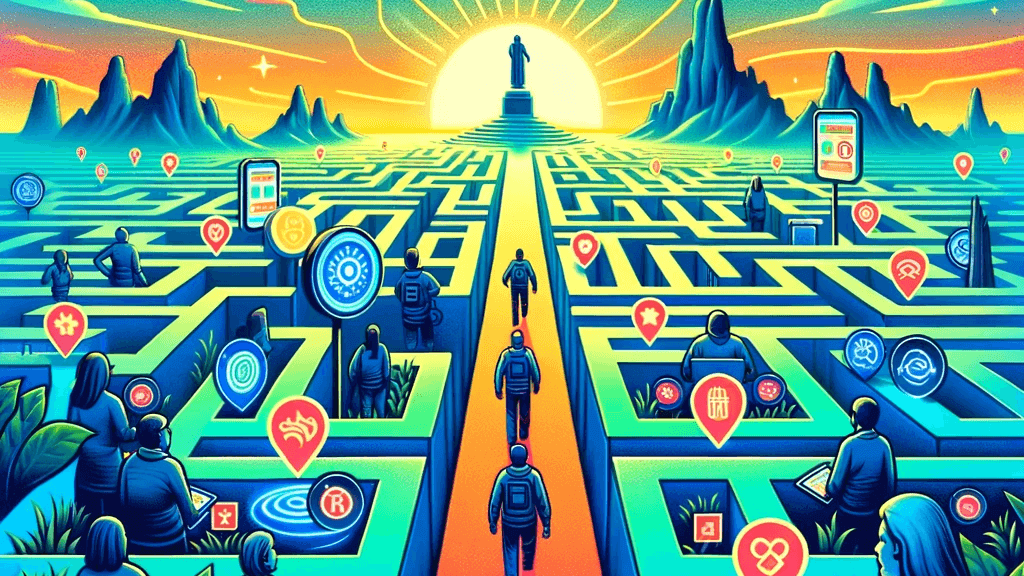
Use The Psychology Of Gamification To Level-Up Your Life
Nov 22, 2023
By Will Moore
In our quest for self-improvement, we often overlook a powerful ally hidden in plain sight: the psychology of gamification. At its core, gamification taps into the same elements that make video games captivating and translates them into everyday life.
Imagine transforming routine tasks into engaging quests, using game design elements to spark a renewed sense of motivation. By harnessing the principles of gamification, we can turn the mundane into the extraordinary, making each day a step towards self growth journey.
In this journey, we'll explore how playing games can teach us valuable lessons about user behavior, motivation, and the art of achieving goals. Whether it's fitness, learning, or personal finance, applying game elements in non-game contexts can offer a unique pathway to success.
So, let's dive into how the psychology of gamification not only makes life more enjoyable but also helps us accomplish goals and achieve our deepest aspirations with playful intention and strategic action.
Key Takeaways
Unlock the Power of Gamification: Learn how integrating game elements into daily activities can transform the mundane into engaging and rewarding experiences. By understanding the psychology of gamification, we can create systems that not only enhance enjoyment but also drive personal growth.
Harness Positive Psychology: Gamification isn't just about adding fun; it's rooted in solid psychological principles. Utilize gamification strategies to tap into positive psychology, fostering lasting growth and development in both personal and professional realms.
Level Up in Life's Core Areas: Apply gamification to key aspects of life tied to deep, soul-filling, long-term happiness. Your 5 Core areas of life include: 1) Mindset, 2) Career & Finances, 3) Relationships) 4) Physical health, and 5) Emotional & Mental Health.mindset, career, relationships, physical health, and emotional well-being. Each area offers unique challenges and opportunities for growth, where gamification can provide a structured yet flexible framework for progress.
The Science Behind Gamification
At the heart of why gamification works so well lies a deep understanding of human behavior and game mechanics. It's a fascinating intersection where psychology meets play. Here’s how it unfolds:

Engagement through Game Mechanics: Game mechanics like points, levels, and progress bars are more than just entertaining; they're rooted in our psychological need for achievement and recognition. They provide positive feedback that motivates us to keep pushing forward.
Behavioral Insights: Gamification taps into fundamental aspects of human behavior. For instance, the use of virtual status symbols and loyalty points in games mirrors our social needs for status and belonging in real life. This deepens our emotional connection to the activities, making them more engaging and enjoyable.
Sustained Motivation: Gamification leverages both intrinsic (internal) and extrinsic (external) motivators. While points and rewards (extrinsic) initially draw us in, it’s the internal satisfaction and personal growth (intrinsic) that keep us engaged in the long term.
Understanding these principles shows us why gamification is more than just a buzzword. It’s a potent tool rooted in psychology and refined through game design elements, capable of profoundly impacting our motivation and engagement.
Self-Determination Theory in Gamification
Self-Determination Theory (SDT) provides a robust framework for understanding how gamification can be optimally designed to boost user satisfaction and motivation. At its core, SDT focuses on three key needs: autonomy, competence, and relatedness.

Autonomy: Gamification encourages users to make their own choices, tailoring challenges and goals to their personal preferences and thus fostering a sense of control and independence.
Competence: Through incremental challenges and real-time positive feedback, gamification systems help users feel a sense of accomplishment and skill development. This is where progress bars and levels in games shine, providing clear markers of progress and success.
Relatedness: Many gamification strategies integrate social elements, like leaderboards or sharing achievements, which tap into our inherent desire as social animals to connect and compare with others. This not only fuels friendly competition but also nurtures a sense of community and belonging.
Understand the concept of Impulse Purchase Cycle in this Blog
By aligning gamification with the principles of SDT, we can create experiences that resonate on a deeper psychological level, fostering long-lasting engagement and personal growth.
Positive Psychology and Gamification
The field of positive psychology dovetails perfectly with gamification. It focuses on enhancing well-being and exploring individual strengths, rather than just fixing problems. Here's how gamification enriches this approach:
Enhancing Happiness: By integrating game-like elements into everyday activities, gamification makes the journey towards personal goals more enjoyable. It also helps to transform habitual behavior. This aligns with the positive psychology aim of increasing overall happiness and life satisfaction.
Building Resilience: Challenges within gamification mirror life's hurdles. Successfully navigating these in a game setting can build resilience and a growth mindset, crucial components of positive psychology.
Improving Relationships: Gamification strategies can include social aspects, like team challenges or sharing successes, which helps to connect with people, foster better relationships and social connectedness, a key tenet of positive psychology.
Personal Growth: Gamification encourages users to set and achieve goals, leading to a sense of accomplishment and personal development, resonating with the core values of positive psychology.
Incorporating gamification into our daily lives can thus be a powerful method to not only engage and entertain but also to support psychological well-being and growth
Understanding Human Behavior and Game Mechanics
The effectiveness of gamification lies in its astute application of game mechanics that resonate with human behavior. This synergy creates immersive experiences that drive engagement and motivation. Here's how it unfolds:
Flow and Mastery: Game mechanics are designed to challenge users at just the right level, promoting a state of flow. This alignment with one’s skill level ensures continuous engagement and a sense of mastery, essential for long-term motivation.
Behavioral Triggers: Gamification utilizes psychological triggers like rewards, friendly competition, and social relatedness. These elements tap into our innate desires, influencing our actions and encouraging continuous participation.
Memory and Recall: Certain game mechanics, such as unfinished tasks in a gamified system, leverage the Zeigarnik effect, where users feel a better recall rate for unfinished tasks. This keeps users coming back to complete their goals.
Emotional Engagement: The emotional journey in gamification is crucial. Achieving goals, overcoming challenges, and earning rewards generate positive emotions, strengthening the emotional connection with the tasks at hand.
By understanding these aspects of human behavior, gamification becomes more than just a tool for entertainment; it transforms into a powerful method for improving productivity, learning, and personal development.
The Power of Play in Non-Game Contexts
Integrating gamification into non-game contexts is a transformative strategy, extending the joy and engagement of play into various aspects of our lives. From apps that make exercise a fun adventure to financial planning tools awarding virtual status symbols for successful savings.

Here’s how this application of gamification can revolutionize everyday experiences:
Transforming Routine Tasks: By applying game elements like point systems and achievement badges to routine activities, we can turn mundane tasks into exciting challenges. This not only increases user engagement but also infuses a sense of fun into our daily routines.
Enhancing Learning and Development: In educational settings or online courses, gamification can significantly increase engagement and improve the learning process. Using techniques like earning points for completing lessons or engaging in friendly competition with peers makes learning more interactive and enjoyable.
Motivating Physical and Mental Wellness: Fitness apps that incorporate gamification strategies, like virtual races or wellness challenges, encourage users to maintain healthy habits. Similarly, mental health apps use game-like elements to promote practices like meditation or journaling, enhancing emotional and mental health.
Professional Growth and Team Success: In the workplace, gamification can foster a culture of achievement and collaboration. Setting up team challenges or using progress bars for project milestones can significantly boost a team's success and individual performance.
By applying the principles of gamification across different domains, we can harness its power to make our endeavors more engaging, enjoyable, and effective.
Choosing the Right Game Elements
Selecting the appropriate game elements is crucial for an effective gamification strategy. It’s about finding the right mix that resonates with individual preferences and goals. Here's how to choose these elements wisely:
Align with Objectives: The game elements you choose should directly support the goals you're aiming to achieve. Whether it’s improving productivity, learning a new skill, getting rid of top unhelpful habits everyone should quit, learning how to upgrade your lifestyle, or enhancing personal health, each element should be purposefully selected to align with these objectives.
Understand Your Audience: Different game elements appeal to different people. Understanding user behavior is key to selecting elements that will genuinely engage and motivate your audience. For instance, some may prefer earning points for tasks, while others might find progress bars more motivating.
Balance Challenge and Accessibility: The chosen game elements should be challenging enough to keep users engaged but not so difficult that they become discouraging. This balance is essential to maintain user interest and participation over time.
Encourage Social Interaction: Incorporating elements that promote social relatedness, like leaderboards or team challenges, can foster friendly competition and community building, key aspects of sustained engagement and motivation.
By carefully selecting and implementing the right game elements, you can create a gamification experience that is not only engaging and enjoyable but also highly effective in achieving the desired outcomes.
Balancing Intrinsic and Extrinsic Motivation in Gamification
A key aspect of gamification is the balance between intrinsic and extrinsic motivation. This balance is essential for sustaining engagement and ensuring that gamification remains effective over time. Let’s explore how this balance can be achieved:
Understanding Intrinsic Motivation: Intrinsic motivation comes from within; it’s driven by personal satisfaction and interest in the task itself. Gamification can foster this by aligning game elements with the user’s personal interests and goals, creating a sense of accomplishment and purpose.
Leveraging Extrinsic Motivation: Extrinsic motivators, such as rewards, points, or virtual status symbols, initially attract and engage users. These elements can be powerful drivers, especially when users start a new activity or work towards a specific goal.
Creating a Synergistic Effect: The most effective gamification strategies combine both intrinsic and extrinsic motivators. For instance, while users earn points (extrinsic), they also experience personal growth or learn new skills (intrinsic), which keeps them engaged in the long term.
Avoiding Over-Reliance on Rewards: It’s important to ensure that the use of rewards and extrinsic motivators doesn't overshadow the intrinsic value of the activity. Over-reliance on rewards can reduce personal satisfaction and long-term engagement.
Learn more about Discipline and Consistency
By striking the right balance between these two types of motivation, gamification can lead to more meaningful engagement and lasting behavioral change.
How To Use The Psychology Of Gamification To Level-Up Your Life
Now that you have gained a deeper understanding of how gamification works, let’s see how to employ it in order to improve various aspects of your daily life. From physical health and emotional well-being to relationships, mindset, and finances.
Gamify Your Physical Health
Achieve greater physical health and make the process of doing so fun with gamification strategies. Start your journey by setting up individualized challenges, tracking progress along a personal barometer, or rewarding yourself for accomplishments like hitting certain numbers in terms of workouts or weight loss.
Be proud as you fill up the visual representation - which will unlock higher levels within fitness and well-being goals – all while having an enjoyable time! Establishing custom quests to better overall wellness is doable when adding gamification elements to all physical-related aspects.
Read More: 7 Ways to Prevent Burnout
Gamify Your Emotional & Mental Health
Utilize apps that track your moods in order to gain “emotional XP” when you effectively manage stress or do activities that bring pleasure.
Establish “mental health challenges” like meditation, journalling regularly, or executing cognitive behavioral therapy practices for a given number of days as well as reward yourself with self-care events such as going out for pampering sessions, enjoying meals that are favorites among other things, and indulging in particular activities or hobbies prized by oneself each time milestones come around.
Gamifying emotional wellness encourages the emergence of resilience while allowing personal growth coupled with an enhanced understanding of ourselves through this positive feedback loop method developed from within us.
Gamify Your Relationships
Construct a “relationship leaderboard” as an instrument for keeping track of thoughtful actions, displaying acts of kindness, or recording time spent with cherished ones. Set up “questions” like scheduling a date night, communicating with an old friend, and having meaningful conversations with family members - then reward yourself by collecting “points”.
Use them at any given moment to treat yourself to something special! This way you’re offering nurturing connections plus loads more moments shared together amongst loved ones that only reinforce their bond Apart from each other.
Gamify Your Mindset
By creating a “mindset meter” that increases with positive self-talk, successfully tackling difficulties or exhibiting resilience. And setting your own “quests” like reading books to aid personal growth, attending seminars on the subject, or activities involving creative thinking, you can begin unlocking the hidden potential of your mind.
Giving yourself badges and loyalty points as rewards for achieving new levels of understanding or instilling success habits encourages gamifying one’s mindset which will enable them to confront life obstacles confidentially and courageously.
Read More a detailed article on Inversion Thinking
Gamify Your Career and Finances
Generate “career quests” such as connecting with a specific amount of contacts from the same industry, working through online courses or achieving an important task or accomplishment in your job. Make a “financial freedom meter” that increases when you pay off debts, monitor savings, or build investments.
Concentrate on customer loyalty for prolonged success and prosperity. Use your team's success and accomplishments to Advance yourself professionally and financially by utilizing gamifying strategies. This will improve the chances of both short-term results and long-term benefits at work, leading to financial stability.
Summary - Psychology Of Gamification
In conclusion, the psychology of gamification offers a unique and powerful approach to personal development and achievement. By leveraging game elements in non-game contexts, we can transform everyday activities into engaging and rewarding experiences.
Whether it's about improving our health, enhancing our emotional well-being, strengthening relationships, advancing in our careers, or developing a resilient mindset, gamification provides a structured yet flexible framework to help us succeed.
The key is to understand how gamification works - tapping into both intrinsic and extrinsic motivators, aligning activities with our personal goals, and using game mechanics to make the process enjoyable.
As we incorporate these elements into our daily lives, we unlock new levels of engagement, motivation, and satisfaction.
Ready Player One?
CLICK HERE to begin gamifying your life immediately! 🚀🚀🚀
Find out what it means to "fire on cylinders" by determining where you currently stand in each of the 5 Core Areas Of Your Life with our FREE CORE EVALUATION QUIZ!
Frequently Asked Questions
What is the gamification theory in psychology?
Gamification in psychology refers to the application of game design elements and principles in non-game contexts to enhance user engagement, motivation, and behavior. It involves using mechanics from video games, such as rewards, progress bars, and challenges, to make activities more interactive and enjoyable. This approach leverages the psychology of gamification, influencing user behavior in a positive way and making learning or task completion more compelling.
What are the psychological effects of gamification?
Gamification has several psychological effects. It can boost motivation and engagement by making tasks more enjoyable and rewarding. The incorporation of game elements like earning points or receiving positive feedback enhances users' emotional connection to the activity. This heightened engagement can lead to better performance, increased persistence, and a more profound sense of accomplishment.
What is the neuroscience behind gamification?
The neuroscience behind gamification involves the stimulation of the brain's reward system. When users engage in gamified activities, there's a release of dopamine, a neurotransmitter associated with feelings of pleasure and motivation. This release encourages users to continue engaging with the task, as the brain associates the activity with a rewarding experience. Additionally, gamification can enhance creativity and problem-solving skills by engaging different parts of the brain in a fun and dynamic way.
